The flavor compounds market is projected to grow from USD 29.7 billion in 2025 to USD 52.7 billion by 2035, reflecting a CAGR of 5.9%. During the early adoption phase (2020–2024), manufacturers and food producers gradually increased the use of flavor compounds to enhance taste and consistency in processed foods, beverages, and snacks. By 2025, growing acceptance across retail and industrial food segments will drive market expansion.
This phase represents the shift from selective use to broader incorporation in products, as companies build supply chains and capacity to meet increasing demand, laying the foundation for the scaling phase. From 2025 to 2030, the market enters a scaling phase, characterized by accelerated adoption across multiple food and beverage categories. Market value grows from USD 29.7 billion in 2025 as production and distribution expand and more product lines integrate flavor compounds. By 2030, flavor compounds will become a standard component in many processed food products, preparing the market for consolidation.
Between 2030 and 2035, growth continues steadily, reaching USD 52.7 billion, with consolidation driven by leading manufacturers optimizing supply chains and capturing larger market shares, resulting in a mature and competitive landscape.
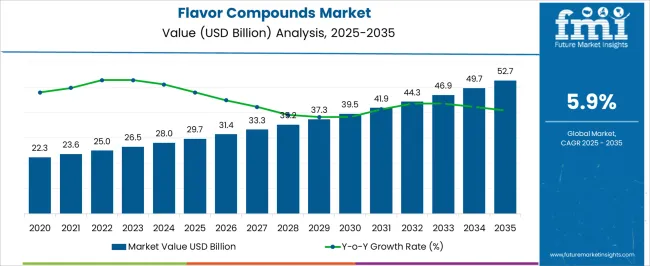
| Metric | Value |
|---|---|
| Flavor Compounds Market Estimated Value in (2025 E) | USD 29.7 billion |
| Flavor Compounds Market Forecast Value in (2035 F) | USD 52.7 billion |
| Forecast CAGR (2025 to 2035) | 5.9% |
The flavor compounds market is a key segment of the global food additives and ingredients market, which encompasses sweeteners, preservatives, colorants, and texturizers. In 2025, flavor compounds account for approximately 18% of the overall food additives market, reflecting their widespread use in processed foods, beverages, and snacks to enhance taste and sensory appeal. The broader food additives market is projected to grow at a CAGR of 4–5% during 2025–2035, supported by increasing consumption of packaged and convenience foods across global markets.
Within the flavor and fragrance segment, flavor compounds hold an estimated 40% share in 2025, while fragrances and essential oils account for the remainder. By 2030, scaling up adoption is expected to increase the share of flavor compounds in the segment to nearly 44%, driven by the rising incorporation of these compounds in beverages, bakery, dairy, and savory products. Between 2030 and 2035, consolidation is expected to stabilize market shares, with leading players strengthening production capabilities and distribution networks. By 2035, flavor compounds are projected to represent roughly 19–20% of the total food additives market and over 45% of the flavor and fragrance segment, underscoring their critical role in driving revenue growth within the parent market.
The flavor compounds market is experiencing steady expansion, supported by growing demand for enhanced taste experiences in food and beverage formulations across global markets. Rising consumer inclination toward differentiated sensory profiles and the proliferation of packaged and functional foods have driven higher utilization of flavor compounds across diverse applications. The current market scenario is characterized by technological advancements in flavor extraction, encapsulation, and stabilization, ensuring longer shelf life and improved integration into final products.
Increased urbanization, premiumization of food offerings, and the widening influence of global cuisines are contributing to broader adoption rates. Moreover, the surge in health-oriented innovations is leading to the creation of flavor compounds that can maintain palatability in reduced-sugar, reduced-salt, or plant-based products.
Regulatory frameworks emphasizing food safety and ingredient transparency are shaping product development, fostering trust and acceptance. The flavor compounds market is expected to benefit from sustained growth in convenience foods, sports nutrition, and personalized nutrition, cementing its role as a critical component in the global food ingredient landscape.
The flavor compounds market is segmented by flavor, application, and geographic regions. By flavor, flavor compounds market is divided into Salty, Fruity, Savory, Spicy, and Sweet. In terms of application, flavor compounds market is classified into Protein Bars, Snacks, and Meat Alternatives. Regionally, the flavor compounds industry is classified into North America, Latin America, Western Europe, Eastern Europe, Balkan & Baltic Countries, Russia & Belarus, Central Asia, East Asia, South Asia & Pacific, and the Middle East & Africa.
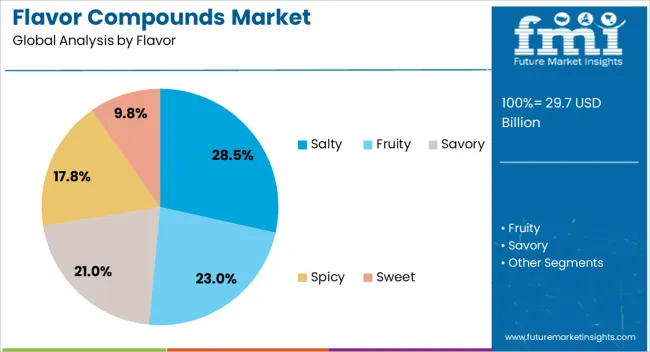
The salty segment holds a leading position in the flavor category of the flavor compounds market, accounting for approximately 28.5% of total share. This dominance is driven by the segment’s integral role in snack manufacturing, processed foods, and ready-to-eat meal solutions, where salt-based flavor compounds enhance palatability and consumer satisfaction. Growth in this segment has been supported by innovations in sodium-reduction technologies that retain taste while addressing health-conscious consumer preferences.
Additionally, the rising global popularity of savory snack formats, ethnic cuisines, and protein-enriched meals has reinforced the demand for salty flavor compounds. The segment also benefits from its versatility, being widely applicable across both mainstream and premium food products.
Technological improvements in flavor masking and controlled release have further expanded its relevance in functional foods and meal replacements. With consumer demand for bold and authentic savory experiences showing no signs of decline, the salty segment is poised to maintain its leadership position over the forecast period.
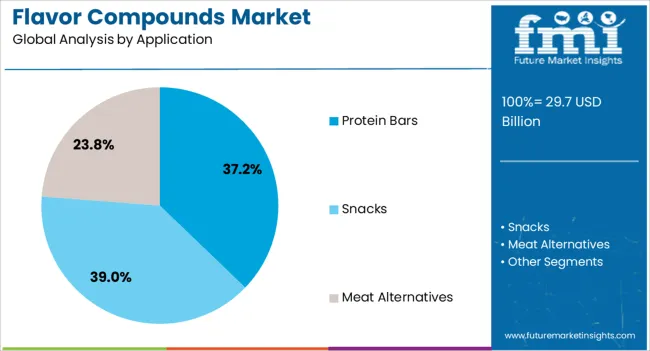
The protein bars segment leads the application category in the flavor compounds market, commanding approximately 37.2% of the total share. This leadership is primarily attributed to the global rise in health, wellness, and sports nutrition trends, where protein bars are positioned as convenient, nutrient-dense snacks. Flavor compounds play a pivotal role in masking the natural bitterness or grainy texture of protein ingredients, ensuring consumer appeal and repeat purchase.
Growth in this segment has been propelled by product diversification into indulgent flavors, seasonal variants, and functional blends enriched with vitamins, minerals, or adaptogens. Advances in flavor encapsulation and heat stability have enabled flavor consistency in protein bars throughout their shelf life, supporting large-scale production and distribution.
The segment’s growth trajectory is further reinforced by expanding retail penetration, e-commerce availability, and targeted marketing toward active lifestyles. As demand for high-protein, on-the-go nutrition continues to escalate, the protein bars segment is expected to remain the most significant application for flavor compounds.
The flavor compounds market is expanding due to rising demand for natural, clean-label, and functional flavors across beverages, processed foods, and confectionery. North America and Europe lead adoption with advanced R&D, stringent regulatory frameworks, and consumer preference for high-quality flavors. Asia-Pacific is growing rapidly with increased processed food consumption, urbanization, and rising disposable incomes. Manufacturers differentiate through natural sourcing, compound stability, and versatility. Regional differences in taste preferences, regulatory standards, and ingredient availability strongly influence adoption, product development, and global competitiveness.
Consumer preference for natural and clean-label products is driving demand for flavor compounds. North America and Europe prioritize naturally sourced compounds from fruits, herbs, and spices to meet consumer expectations and regulatory scrutiny. Asia-Pacific markets are increasingly adopting natural flavors, supported by growing processed food and beverage consumption, though cost and availability remain key considerations. Differences in taste profiles, cultural preferences, and ingredient sourcing influence compound formulation and concentration. Leading suppliers invest in extraction technologies and flavor stabilization methods to ensure consistent quality, while regional producers focus on affordable, locally sourced options. The contrast between premium, natural-focused Western markets and cost-conscious emerging regions shapes adoption trends, product innovation, and competitiveness globally.
Functional and specialty flavors are increasingly incorporated into nutraceuticals, fortified beverages, and specialty foods. North America and Europe emphasize flavors that mask off-notes from proteins, vitamins, or fiber, ensuring consumer acceptability and maintaining sensory experience. Asia-Pacific markets adopt functional flavors for fortified beverages, dairy products, and snack foods to meet nutritional needs while appealing to local taste preferences. Differences in product complexity, consumer awareness, and regulatory acceptance influence compound selection and formulation strategies. Leading suppliers develop multi-functional, stable flavors compatible with diverse matrices, while regional producers focus on simplified, cost-effective blends. Functional and specialty flavor contrasts drive adoption, product differentiation, and competitiveness across the global flavor compounds market.
Regulatory frameworks significantly impact flavor compound adoption. North America and Europe enforce stringent regulations for GRAS status, allergen labeling, and maximum usage limits, guiding flavor selection and product development. Asia-Pacific markets vary; developed regions follow international standards, while emerging regions adopt flexible local regulations. Differences in approval timelines, testing requirements, and food safety enforcement influence compound formulation, sourcing, and market entry. Leading suppliers provide fully compliant, documented flavor compounds with traceability, while regional players offer cost-effective, approved solutions. Regulatory contrasts drive adoption patterns, consumer trust, and competitiveness, making compliance a key factor in global flavor compounds market growth.
Advances in extraction, encapsulation, and stabilization technologies enhance flavor compound performance. North America and Europe prioritize encapsulated flavors, spray-dried powders, and liquid concentrates that maintain potency during processing, storage, and high-temperature applications. Asia-Pacific markets adopt technologically enhanced compounds selectively, balancing cost and performance for mass-market foods and beverages. Differences in processing techniques, ingredient interactions, and storage conditions influence compound selection, application, and formulation. Leading suppliers invest in R&D to improve solubility, shelf life, and sensory impact, while regional players focus on practical, cost-effective solutions. Technological contrasts shape adoption, product performance, and competitiveness across the global flavor compounds market.
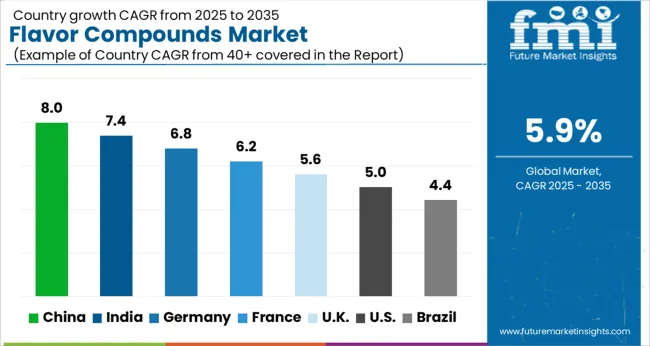
| Country | CAGR |
|---|---|
| China | 8.0% |
| India | 7.4% |
| Germany | 6.8% |
| France | 6.2% |
| UK | 5.6% |
| USA | 5.0% |
| Brazil | 4.4% |
The global flavor compounds market is projected to grow at a 5.9% CAGR through 2035, driven by demand in food and beverage, confectionery, and nutritional products. Among BRICS nations, China led with 8.0% growth as large-scale production and deployment were executed to meet rising consumer and industrial requirements, while India at 7.4% expanded manufacturing and supply chain capabilities across domestic and export markets. In the OECD region, Germany at 6.8% maintained steady utilization under stringent food safety and quality standards, while the United Kingdom at 5.6% implemented moderate-scale deployment in processed foods and beverages. The USA, growing at 5.0%, supported consistent adoption in commercial and retail applications while adhering to federal and state-level regulatory frameworks. This report includes insights on 40+ countries; the top countries are shown here for reference.
The flavor compounds market in China is expanding at an 8.0% CAGR, driven by growing demand from the food and beverage industry. Rising consumer preference for processed and packaged foods is increasing the use of natural and synthetic flavoring solutions. Domestic manufacturers are investing in research and development to produce innovative flavors tailored to regional taste preferences. E-commerce and modern retail channels are improving accessibility, allowing small and medium enterprises to procure high-quality flavor compounds efficiently. Health-conscious consumers are showing greater interest in natural, clean-label flavors, encouraging companies to reformulate products. Institutional buyers such as bakeries, confectioneries, and beverage producers are driving bulk demand. Marketing strategies highlight product safety, regulatory compliance, and consistency, building trust among manufacturers and consumers alike. Overall, the market reflects a combination of convenience, innovation, and evolving consumer taste preferences.
Flavor compounds market in India is registering a 7.4% CAGR, supported by the growing packaged food and beverage industry. Urbanization, rising disposable incomes, and changing lifestyles are driving demand for processed snacks, beverages, and bakery products. Domestic and international manufacturers are introducing flavors suited to Indian taste profiles, including spices and fruit-based blends. Retail chains, modern trade, and e-commerce platforms are increasing availability and reducing procurement challenges for food producers. Institutional buyers such as hotels, restaurants, and confectioneries are significant contributors to volume growth. Consumers are increasingly seeking natural and plant-based flavors, reflecting a shift toward healthier options. Regulatory compliance and quality assurance remain key priorities for manufacturers to maintain safety standards. Innovation in flavor technology, combined with growing market penetration, is supporting steady growth.

Germany’s flavor compounds market is growing at a 6.8% CAGR, supported by strong food and beverage manufacturing and high consumer expectations for quality. Companies focus on natural and clean-label flavors, catering to health-conscious consumers. Packaged foods, dairy, beverages, and confectioneries are major applications driving demand. Manufacturers emphasize sustainable sourcing and environmentally responsible production practices. Retailers and distributors are offering a wide range of flavor solutions to meet industrial and small-scale requirements. Regulatory standards ensure product safety and compliance with European Union guidelines, instilling confidence among buyers. Innovation in functional and premium flavors is increasingly important as consumer preferences evolve. The market growth is shaped by strong industrial demand, regulatory oversight, and a focus on sustainable, high-quality flavor offerings.
The United Kingdom flavor compounds market is expanding at a 5.6% CAGR, driven by consumer demand for processed foods, beverages, and confectioneries. Manufacturers are focusing on natural, clean-label, and plant-based flavors to align with evolving health and wellness trends. Retailers and online distributors provide easy access to flavor compounds for industrial and small-scale food producers. Institutional buyers including bakeries, restaurants, and beverage companies continue to support volume growth. Sustainability and environmentally friendly sourcing are gaining importance, influencing product selection. Regulatory compliance and quality assurance remain essential, ensuring safe usage in food applications. Innovation in flavor technology, including functional and premium offerings, is helping companies differentiate products. Overall, the market is characterized by steady growth supported by consumer trends and industrial adoption.
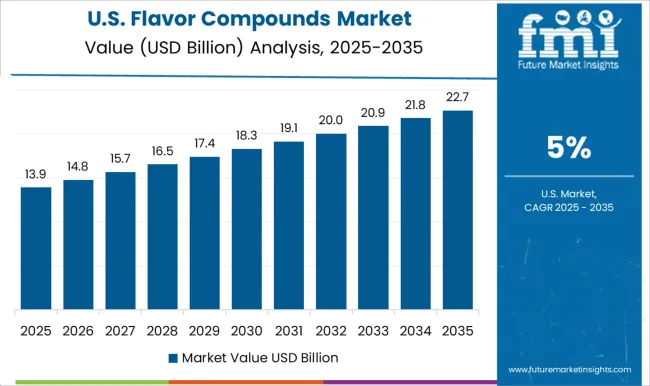
The United States flavor compounds market is growing at a 5.0% CAGR, reflecting steady demand from packaged food, beverage, and confectionery sectors. Consumers are increasingly seeking natural, clean-label, and plant-based flavors, prompting manufacturers to innovate accordingly. Food producers rely on both synthetic and natural flavor solutions to meet diverse taste profiles and regulatory standards. Retailers, online suppliers, and distributors provide widespread availability to industrial and smaller food manufacturers. Institutional demand from restaurants, bakeries, and beverage producers continues to support steady market expansion. Emphasis on product safety, quality assurance, and regulatory compliance ensures consistent adoption. The market is characterized by innovation in flavor technology, growing interest in functional flavors, and a preference for environmentally responsible production methods. Overall, convenience, consumer preferences, and regulatory standards guide market growth.
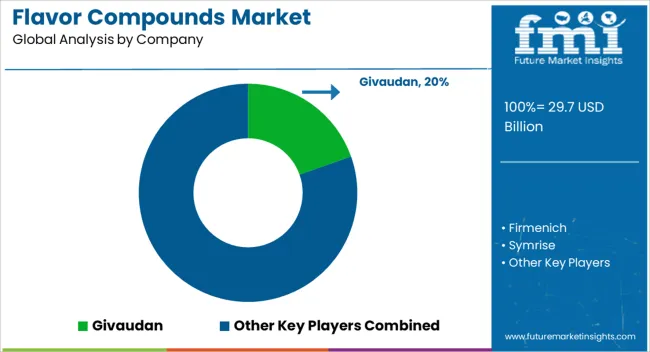
The flavor compounds market is dominated by leading global suppliers such as Givaudan, Firmenich, Symrise, IFF (International Flavors & Fragrances), Sensient Technologies, Kerry Group, Takasago International Corporation, FONA International, Frutarom (now part of IFF), and Tate & Lyle. These companies specialize in creating natural and artificial flavor solutions for the food, beverage, and personal care industries. Market growth is driven by increasing consumer demand for innovative flavors, clean-label products, and enhanced taste experiences. Leading suppliers are investing in advanced research and development to create novel, high-quality flavor profiles while complying with stringent regulatory standards across different regions. Innovation and product diversification are key strategies adopted by the top players in the flavor compounds market. Companies like Givaudan, Firmenich, and Symrise are developing natural, plant-based, and sustainable flavors to meet the rising demand for organic and eco-friendly products. Suppliers such as IFF and Sensient Technologies are emphasizing customized flavor solutions tailored to specific consumer preferences and regional tastes. Moreover, the integration of technology-driven processes such as digital flavor modeling and sensory analytics is being leveraged to improve flavor consistency and accelerate product development cycles. Strategic expansion and partnerships further strengthen the market position of these suppliers. Kerry Group, Takasago International Corporation, and Frutarom are expanding their production capabilities through acquisitions and joint ventures, ensuring global supply chain efficiency and regional presence. By maintaining high-quality standards, regulatory compliance, and innovative offerings, these companies continue to dominate the flavor compounds market. With increasing consumer interest in exotic, functional, and natural flavors, the market is expected to witness steady growth, driven by the expertise and global reach of these leading suppliers.
| Item | Value |
|---|---|
| Quantitative Units | USD 29.7 Billion |
| Flavor | Salty, Fruity, Savory, Spicy, and Sweet |
| Application | Protein Bars, Snacks, and Meat Alternatives |
| Regions Covered | North America, Europe, Asia-Pacific, Latin America, Middle East & Africa |
| Country Covered | United States, Canada, Germany, France, United Kingdom, China, Japan, India, Brazil, South Africa |
| Key Companies Profiled | Givaudan, Firmenich, Symrise, IFF (International Flavors & Fragrances), Sensient Technologies, Kerry Group, Takasago International Corporation, FONA International, Frutarom (now part of IFF), and Tate & Lyle |
| Additional Attributes | Dollar sales vary by compound type, including natural flavors, artificial flavors, and nature-identical flavors; by application, such as beverages, confectionery, bakery, dairy, and savory foods; by end-use industry, spanning food & beverages, nutraceuticals, and personal care; by region, led by North America, Europe, and Asia-Pacific. Growth is driven by rising demand for customized flavors, processed foods, and clean-label products. |
The global flavor compounds market is estimated to be valued at USD 29.7 billion in 2025.
The market size for the flavor compounds market is projected to reach USD 52.7 billion by 2035.
The flavor compounds market is expected to grow at a 5.9% CAGR between 2025 and 2035.
The key product types in flavor compounds market are salty, fruity, savory, spicy and sweet.
In terms of application, protein bars segment to command 37.2% share in the flavor compounds market in 2025.






Our Research Products

The "Full Research Suite" delivers actionable market intel, deep dives on markets or technologies, so clients act faster, cut risk, and unlock growth.

The Leaderboard benchmarks and ranks top vendors, classifying them as Established Leaders, Leading Challengers, or Disruptors & Challengers.

Locates where complements amplify value and substitutes erode it, forecasting net impact by horizon

We deliver granular, decision-grade intel: market sizing, 5-year forecasts, pricing, adoption, usage, revenue, and operational KPIs—plus competitor tracking, regulation, and value chains—across 60 countries broadly.

Spot the shifts before they hit your P&L. We track inflection points, adoption curves, pricing moves, and ecosystem plays to show where demand is heading, why it is changing, and what to do next across high-growth markets and disruptive tech

Real-time reads of user behavior. We track shifting priorities, perceptions of today’s and next-gen services, and provider experience, then pace how fast tech moves from trial to adoption, blending buyer, consumer, and channel inputs with social signals (#WhySwitch, #UX).

Partner with our analyst team to build a custom report designed around your business priorities. From analysing market trends to assessing competitors or crafting bespoke datasets, we tailor insights to your needs.
Supplier Intelligence
Discovery & Profiling
Capacity & Footprint
Performance & Risk
Compliance & Governance
Commercial Readiness
Who Supplies Whom
Scorecards & Shortlists
Playbooks & Docs
Category Intelligence
Definition & Scope
Demand & Use Cases
Cost Drivers
Market Structure
Supply Chain Map
Trade & Policy
Operating Norms
Deliverables
Buyer Intelligence
Account Basics
Spend & Scope
Procurement Model
Vendor Requirements
Terms & Policies
Entry Strategy
Pain Points & Triggers
Outputs
Pricing Analysis
Benchmarks
Trends
Should-Cost
Indexation
Landed Cost
Commercial Terms
Deliverables
Brand Analysis
Positioning & Value Prop
Share & Presence
Customer Evidence
Go-to-Market
Digital & Reputation
Compliance & Trust
KPIs & Gaps
Outputs
Full Research Suite comprises of:
Market outlook & trends analysis
Interviews & case studies
Strategic recommendations
Vendor profiles & capabilities analysis
5-year forecasts
8 regions and 60+ country-level data splits
Market segment data splits
12 months of continuous data updates
DELIVERED AS:
PDF EXCEL ONLINE
Chocolate Flavoring Compounds Market Size and Share Forecast Outlook 2025 to 2035
Flavor Modulator Market Size and Share Forecast Outlook 2025 to 2035
Flavor Emulsions Market Size and Share Forecast Outlook 2025 to 2035
Flavor Masking Agents Market Size and Share Forecast Outlook 2025 to 2035
Flavor Modulators Market Size and Share Forecast Outlook 2025 to 2035
Flavoring Cosmetic Formulation Agents Market Size and Share Forecast Outlook 2025 to 2035
Flavored Whiskey Market Size and Share Forecast Outlook 2025 to 2035
Flavored Butter And Oils Market Size and Share Forecast Outlook 2025 to 2035
Flavoring Oils Market Size and Share Forecast Outlook 2025 to 2035
Flavoring Agents Market Size and Share Forecast Outlook 2025 to 2035
Flavors for Pharmaceutical & Healthcare Applications Market Size and Share Forecast Outlook 2025 to 2035
Flavor Capsule Cigarette Market Analysis - Size, Share, and Forecast 2025 to 2035
Flavored Syrup Market Analysis - Size, Share, and Forecast Outlook 2025 to 2035
Analysis and Growth Projections for Flavor and Flavor Enhancers Market
Flavored Yogurt Market Analysis by Form, Flavor, End Use and Distribution Channel Through 2035
Flavors and Fragrances Market Analysis by Type, Nature, Application, and Region through 2035
Flavor Emulsion Market Analysis by Nature, End-Use, Distribution Channel, and Region - Growth, trends and forecast from 2025 to 2035
Flavor Drops Market Growth - Beverage & Functional Trends 2025 to 2035
Flavored Water Market Trends - Hydration & Wellness Demand 2025 to 2035
Flavored CBD Powder Market Growth - Innovations & Consumer Trends 2025 to 2035

Thank you!
You will receive an email from our Business Development Manager. Please be sure to check your SPAM/JUNK folder too.
Chat With
MaRIA